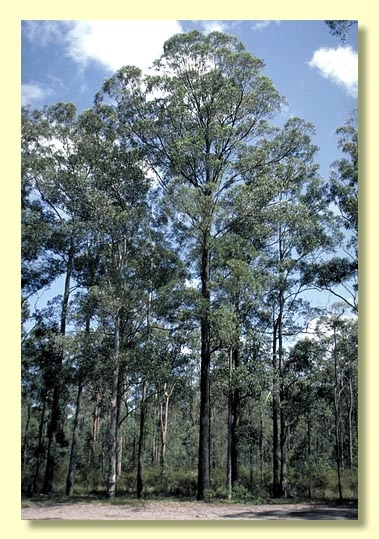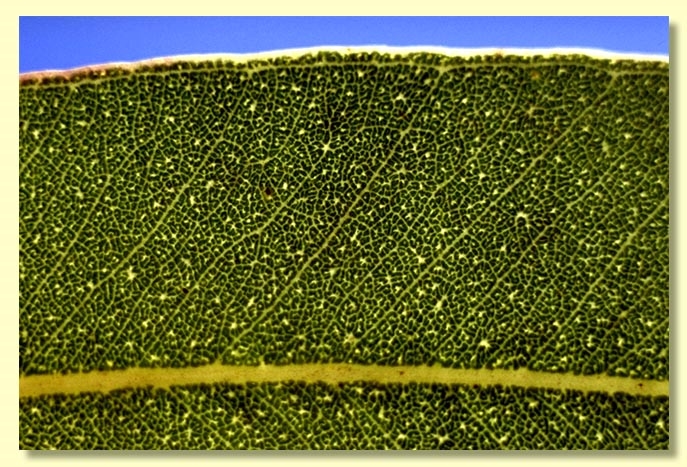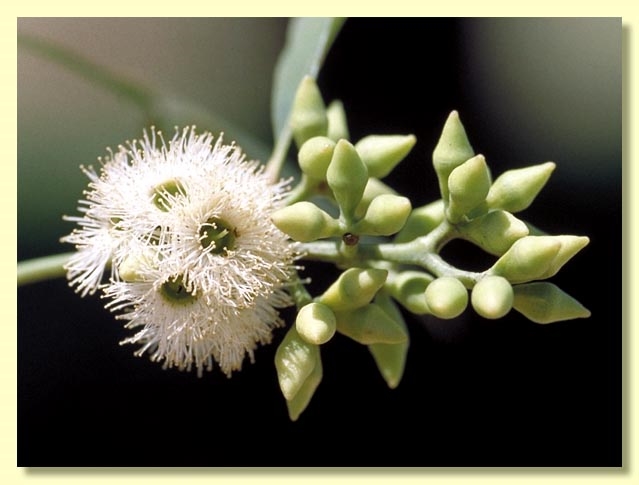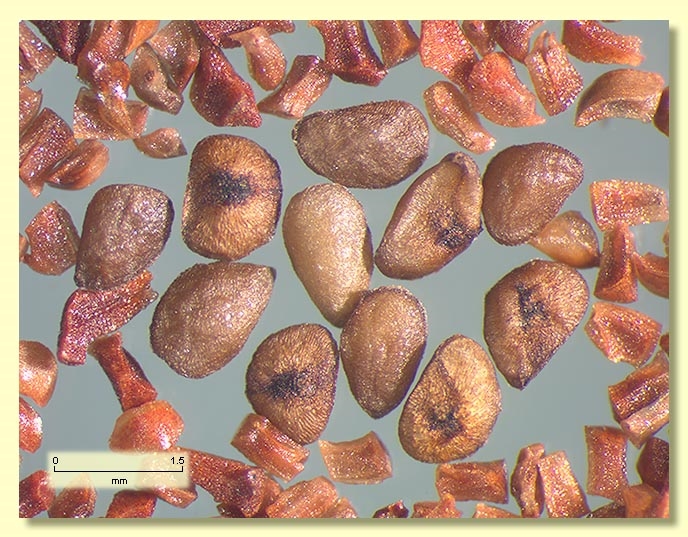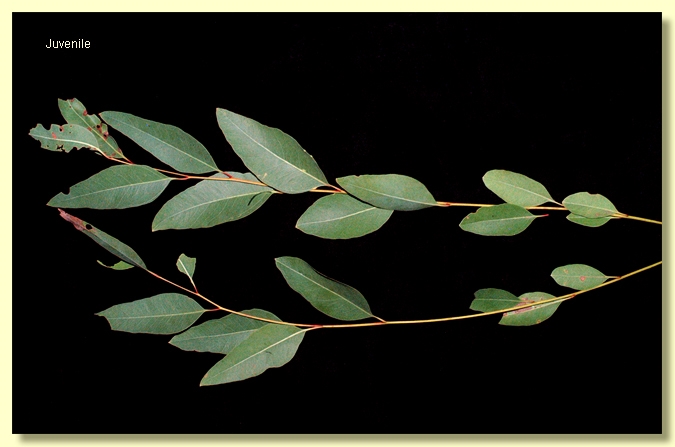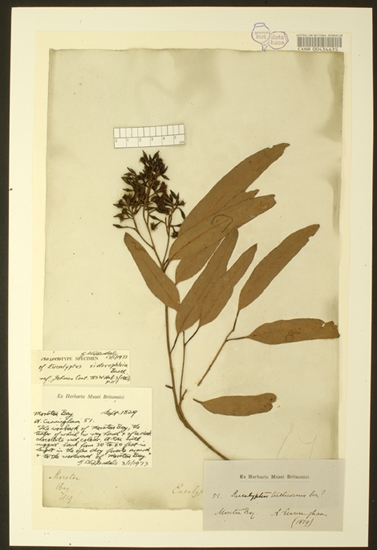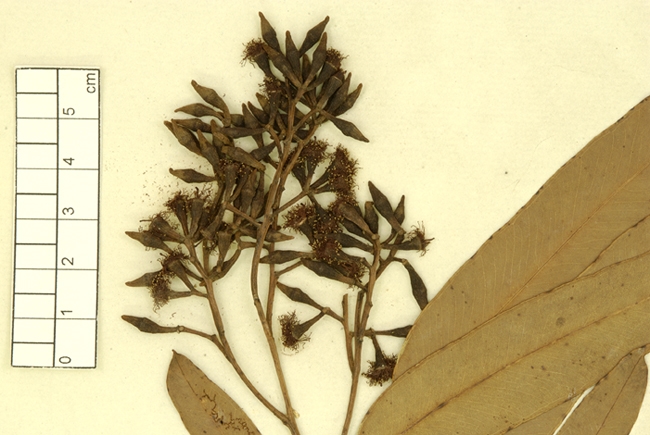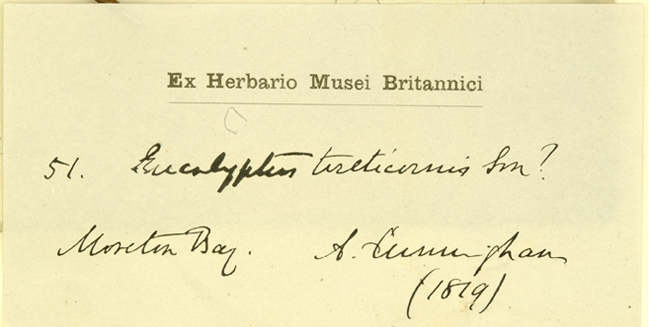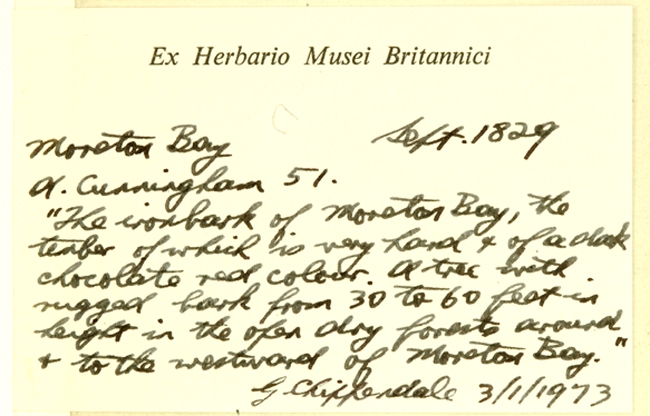Euclid - Online edition
Eucalyptus siderophloia
Eucalyptus | Symphyomyrtus | Adnataria | Apicales | Siderophloiae | Subglaucae
T: Moreton Bay, Qld, Sept. 1829, A.Cunningham 51; lecto: K, fide L.A.S.Johnson, Contr. New South Wales Natl Herb. 3: 117 (1962); isolecto: BM, CANB, NSW, W.
Ironbark to small branches, grey or black, hard, deeply furrowed.
Juvenile growth (coppice or field seedlings to 50 cm): stems square or round in cross-section; juvenile leaves always petiolate, opposite for 4 to 6 nodes then alternate, ovate to lanceolate, 5–12 cm long, 1.5–4.8 cm wide, base tapering to petiole, discolorous, dull to slightly glossy, green.
Adult leaves alternate, petiole 1–2.5 cm long; blade lanceolate to falcate, 8.5–17.5 cm long, 1.5–3 cm wide, base tapering to petiole, concolorous, dull or glossy, green, side-veins greater than 45° to midrib, densely to very densely reticulate, intramarginal vein parallel to and just within margin, oil glands mostly intersectional.
Inflorescence terminal compound and sometimes unbranched in subterminal axils also, peduncles 0.5–1.2 cm long, buds usually 7 per umbel, pedicels 0.2–0.8 cm long. Mature buds diamond-shaped, green to yellow, 0.5–1 cm long, 0.3–0.4 cm wide, scar present, operculum conical, stamens irregularly flexed, anthers adnate, cuboid or globoid, dehiscing by lateral pores or slits, style long, stigma blunt or pin-head shaped, locules 3 or 4, the placentae each with 4 vertical ovule rows. Flowers white.
Fruit on pedicels 0.2–0.6 cm long, cup-shaped or obconical, 0.3–0.8 cm long, 0.4–0.7 cm wide, disc descending, valves 3 or 4, near rim level.
Seeds brown, 1–2.5 mm long, ovoid or flattened-ovoid, dorsal surface smooth or shallowly pitted, hilum ventral.
Cultivated seedlings (measured at ca node 10): cotyledons oblong to reniform; stems square in cross-section; leaves always petiolate, opposite for 4 or 5 nodes then alternate, ovate-lanceolate, 5.5–12 cm long, 1.5–5 cm wide, base rounded or tapering, apex pointed, margin entire, discolorous, slightly glossy, dark green above, paler beneath.
Flowering has been recorded in January, May, July, September, October, November and December.
A medium-sized to tall forest ironbark tree of the coast and adjacent hinterlands of New South Wales and southern Queensland, from Sydney to about Bundaberg. It has diamond-shaped buds with all stamens fertile and obconical to cup-shaped fruit with slightly exserted valves.
Within its area of occurrence, E. siderophloia could be confused with E. fibrosa, E. rhombica, E. decorticans, E. beaniana, E. tholiformis, E. taurina, E. crebra and E. ophitica. All belong to the group of ironbarks where all the stamens are fertile and irregularly flexed. It is probably closest to E. rhombica, E. fibrosa and E. decorticans. All four species can have diamond-shaped to fusiform buds. E. siderophloia differs from both E. rhombica and E. fibrosa by having smaller buds and fruit, the fruit being 0.5–0.7 cm wide in E. siderophloia and up to 1 cm wide for the other two. It can be further separated from E. fibrosa by having a shorter operculum. It is distinguished from E. decorticans by having rough-barked branches, the larger branches in E. decorticans being conspicuously smooth-barked. The fruit shape distinguishes it from E. crebra which has cup-shaped to hemispherical fruit. E. ophitica, E. taurina, E. tholiformis and E. beaniana all have more or less oblong to fusiform to obovoid buds where the operculum is bluntly conical to rounded. The widespread E. melanophloia has a crown of opposite, sessile, glaucous juvenile leaves. Other ironbark species occurring within its area of occurrence have some infertile outer stamens (staminodes), which can be seen by dissecting a bud.
Eucalyptus fracta K.D.Hill, published by K.D.Hill in Telopea 7 (2) 106 (1997), has been described as being closely related to E. siderophloia. It grows on the dry sandstone cliffs that form the ridgeline of the Broken Back Range, south-west of Pokolbin, New South Wales. Like other species in series Siderophloiae, it has terminal inflorescences and the few immature buds that have been seen have an operculum scar and all stamens fertile. Juvenile leaves from coppice at the site are ovate and blue-grey whilst adult leaves are narrowly lanceolate, glossy and green. The fruit on some trees are cupular but taper inwards slightly at the rim whilst on others are more or less obconical, like E. siderophloia, which occurs as a forest tree not far to the south on a better site. So far the authors of EUCLID regard Eucalyptus fracta as doubtfully different from E. siderophloia, or a hybrid between that species and some other eucalypt. Three collecting trips to the area in 2004-2006 have helped little in the understanding of this taxon, the last trip being thwarted by a severe fire which had burnt through the area weeks earlier. Further investigation is required.

